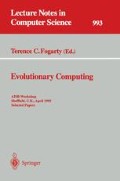Abstract
This paper presents a new technique for handling constraints within evolutionary algorithms, and demonstrates its effectiveness on a real-world, constrained optimisation problem that arises in the design of gas-supply networks. The technique, which we call the COMOGA method (Constrained Optimisation by Multi-Objective Genetic Algorithms), borrows two crucial ideas from multiobjective optimisation and combines them with an adaptive genetic algorithm to yield a method with the same wide applicability as penalty function methods, but with significantly fewer free control parameters and the potential for greater effectiveness.
Initial results reported in this paper first compare the heuristic previously used in practice by British Gas with a genetic approach using a carefully tuned penalty function. On the problem instance studied, the genetic algorithm was able to find a feasible network with a cash cost 4% lower than the previously best-known (and installed) solution. Though successful, the penalty function method suffered from the familiar sensitivity to the settings of the parameters controlling the effective weighting of the constraint functions, and required a reverse annealing schedule to encourage feasible solutions to emerge over time.
The exercise was repeated using the COMOGA method, which treats each of the constraints—explicit or implicit—as a separate criterion in a multi-objective formulation of the problem. The same 4% improvement over the heuristic was achieved with COMOGA, in similar numbers of evaluations and with similar consistency, but with significantly less tuning. This was because of the greatly reduced number of free parameters for which values need to be selected with this method, as well as the algorithm's lower observed sensitivity to these values.
Preview
Unable to display preview. Download preview PDF.
References
D. J. Cavicchio, 1970. Adaptive Search Using Simulated Evolution. PhD thesis, Univerity of Michigan.
Lawrence Davis and David Orvosh, 1993. Shall we repair? Genetic algorithms, combinatorial optimization, and feasibility constraints. In Stephanie Forrest, editor, Proceedings of the Fifth International Conference on Genetic Algorithms. Morgan Kaufmann (San Mateo).
Lawrence Davis, 1991. Handbook of Genetic Algorithms. Van Nostrand Reinhold (New York).
Kenneth A. De Jong, 1975. An Analysis of the Behaviour of a Class of Genetic Adaptive Systems. PhD thesis, University of Michigan.
Carlos M. Fonseca and Peter J. Fleming, 1993. Genetic algorithms for multiobjective optimization: Formulation, discussion and generalization. In Stephanie Forrest, editor, Proceedings of the Fifth International Conference on Genetic Algorithms, pages 416–423. Morgan Kaufmann (San Mateo).
Carlos M. Fonseca and Peter J. Fleming, 1994. Multiobjective evolutionary algorithms: An overview. In Terence C. Fogarty, editor, AISB Workshop on Evolutionary Computing, University of Leeds.
David E. Goldberg and Jon Richardson, 1987. Genetic algorithms for multimodal function optimisation. In Proceedings of the Second International Conference on Genetic Algorithms. Lawrence Erlbaum Associates (Hillsdale).
David E. Goldberg, 1989. Genetic Algorithms in Search, Optimization & Machine Learning. Addison-Wesley (Reading, Mass).
Martina Gorges-Schleuter, 1989. ASPARAGOS: an asynchronous parallel genetic optimization strategy. In Proceedings of the Third International Conference on Genetic Algorithms, pages 422–427. Morgan Kaufmann (San Mateo).
B. Manderick and P. Spiessens, 1989. Fine-grained parallel genetic algorithms. In J. David Schaffer, editor, Proceedings of the Third International Conference on Genetic Algorithms, pages 428–433, San Mateo. Morgan Kaufmann Publishers.
Zbigniew Michalewicz, 1992. Genetic Algorithms + Data Structures = Evolution Programs. Springer Verlag (Berlin).
Michael Norman, 1988. A genetic approach to topology optimisation for multiprocessor architectures. Technical report, University of Edinburgh.
Nicholas J. Radcliffe and Patrick D. Surry, 1994. The Reproductive Plan Language RPL2: Motivation, architecture and applications. In J. Stender, E. Hillebrand, and J. Kingdon, editors, Genetic Algorithms in Optimisation, Simulation and Modelling. IOS Press (Amsterdam).
Nicholas J. Radcliffe, 1994. The algebra of genetic algorithms. Annals of Maths and Artificial Intelligence, 10:339–384.
John T. Richardson, Mark R. Palmer, Gunar Liepins, and Mike Hilliard, 1989. Some guidelines for genetic algorithms with penalty functions. In Proceedings of the Third International Conference on Genetic Algorithms, pages 191–195. Morgan Kaufmann (San Mateo).
J. David Schaffer, 1985. Multiple objective optimization with vector evaluated genetic algorithms. In Proceedings of an International Conference on Genetic Algorithms. Lawrence Erlbaum.
Marc Schoenauer and Spyros Xanthakis, 1993. Constrained GA optimisation. In Stephanie Forrest, editor, Proceedings of the Fifth International Conference on Genetic Algorithms. Morgan Kaufmann (San Mateo, CA).
William M. Spears and Kenneth A. De Jong, 1991. On the virtues of parameterised uniform crossover. In Proceedings of the Fourth International Conference on Genetic Algorithms, pages 230–236. Morgan Kaufmann (San Mateo).
Patrick D. Surry and Nicholas J. Radcliffe, 1994. RPL2: A language and parallel framework for evolutionary computing. In Y. Davidor, H.-P. Schwefel, and R. Männer, editors, Parallel Problem Solving from Nature III, pages 628–637.
Gilbert Syswerda, 1989. Uniform crossover in genetic algorithms. In Proceedings of the Third International Conference on Genetic Algorithms. Morgan Kaufmann (San Mateo).
Author information
Authors and Affiliations
Editor information
Rights and permissions
Copyright information
© 1995 Springer-Verlag Berlin Heidelberg
About this paper
Cite this paper
Surry, P.D., Radcliffe, N.J., Boyd, I.D. (1995). A multi-objective approach to constrained optimisation of gas supply networks: The COMOGA method. In: Fogarty, T.C. (eds) Evolutionary Computing. AISB EC 1995. Lecture Notes in Computer Science, vol 993. Springer, Berlin, Heidelberg. https://doi.org/10.1007/3-540-60469-3_33
Download citation
DOI: https://doi.org/10.1007/3-540-60469-3_33
Published:
Publisher Name: Springer, Berlin, Heidelberg
Print ISBN: 978-3-540-60469-3
Online ISBN: 978-3-540-47515-6
eBook Packages: Springer Book Archive

